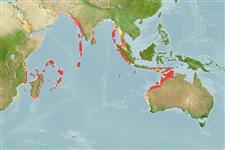>
Eupercaria/misc (Various families in series Eupercaria) >
Labridae (Wrasses) > Xyrichtyinae
Etymology: Iniistius: Latin, in = in + Greek, istion = sail; griffithsi: Named for the collector, Jeremy Griffiths.
Eponymy: Jeremy Griffiths is the son of Owen Griffiths who noted that this was a ‘new’ fish and arranged for a photograph to be taken and a second specimen collected. [...] (Ref. 128868), visit book page.
More on author: Randall.
Environment: milieu / climate zone / depth range / distribution range
экология
морской; пределы глубины 8 - 120 m (Ref. 58466). Tropical
Indian Ocean: Mauritius, Madagascar and Christmas Island.
Size / Вес / Возраст
Maturity: Lm ? range ? - ? cm
Max length : 14.3 cm SL самец/пол неопределен; (Ref. 58466)
Краткое описание
определительные ключи | морфология | морфометрия
колючие лучи спинного плавника (общее число) : 9; членистые (мягкие) лучи спинного плавника (общее число) : 12; колючие лучи анального плавника: 3; членистые (мягкие) лучи анального плавника: 12; позвонки: 25. This species is characterized by the following: Dorsal rays IX,12; anal rays III,12; pectoral rays 12; lateral line interrupted, the pored scales 19-20 + 5 or 6; cheek is naked except for a curved oblique row of 6 small scales from behind to below eye; 1 or 2 small scales dorsoanteriorly on the opercle; gill rakers 19-20; body depth 2.5-2.6 in SL; dorsal profile of snout nearly vertical; first two dorsal spines slender and flexible, the first slightly longer, 2.45-2.55 in head length; space between second and third dorsal spines more than twice that between first and second spines; color when fresh, pale grey, scale edges dorsally on body grey-brown; head grey-brown, operculum suffused with orange, with vertical blue bands; a broad oblique pale blue band containing numerous small black spots
from interorbital space to above opercle; one to several black spots, edged in pale blue, on side of body above tip of pectoral fin; a dusky streak below posterior end of maxilla and lower lip; orangish patch on side of caudal peduncle, each scale with a pale blue spot; median fins bluish grey; pectoral fins orange (Ref. 58466).
Found on sandy bottoms and dives into sand to sleep safely at night or to hide when alarmed (Ref. 90102).
Life cycle and mating behavior
половая зрелость | размножение | нерест | икра | Fecundity | личинки
Distinct pairing during breeding (Ref. 205).
Randall, J.E., 2007. Iniistius griffithsi, a new razorfish (Perciformes: Labridae) from Mauritius. Smithiana Bull. 7:9-13. (Ref. 58466)
Статус Красного Списка МСОП (Ref. 130435: Version 2024-1)
Угроза для людей
Harmless
Использование человеком
рыболовство: коммерческий
дополнительная информация
инструменты
Специальные отчеты
Скачать в формате XML
ресурсы в Интернет
Estimates based on models
Preferred temperature (Ref.
123201): 24.7 - 28.7, mean 27.2 °C (based on 108 cells).
Phylogenetic diversity index (Ref.
82804): PD
50 = 0.5000 [Uniqueness, from 0.5 = low to 2.0 = high].
Bayesian length-weight: a=0.01047 (0.00408 - 0.02689), b=3.06 (2.84 - 3.28), in cm total length, based on LWR estimates for this (Sub)family-body shape (Ref.
93245).
Trophic level (Ref.
69278): 3.4 ±0.5 se; based on size and trophs of closest relatives
устойчивость к внешним воздействиям (Ref.
120179): высокий, минимальное время удвоения популяции до 15 месяцев (Preliminary K or Fecundity.).
Fishing Vulnerability (Ref.
59153): Low vulnerability (10 of 100).
